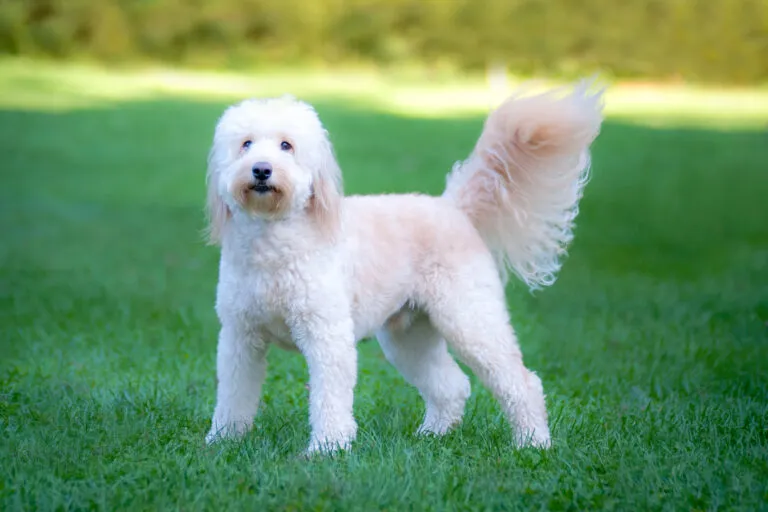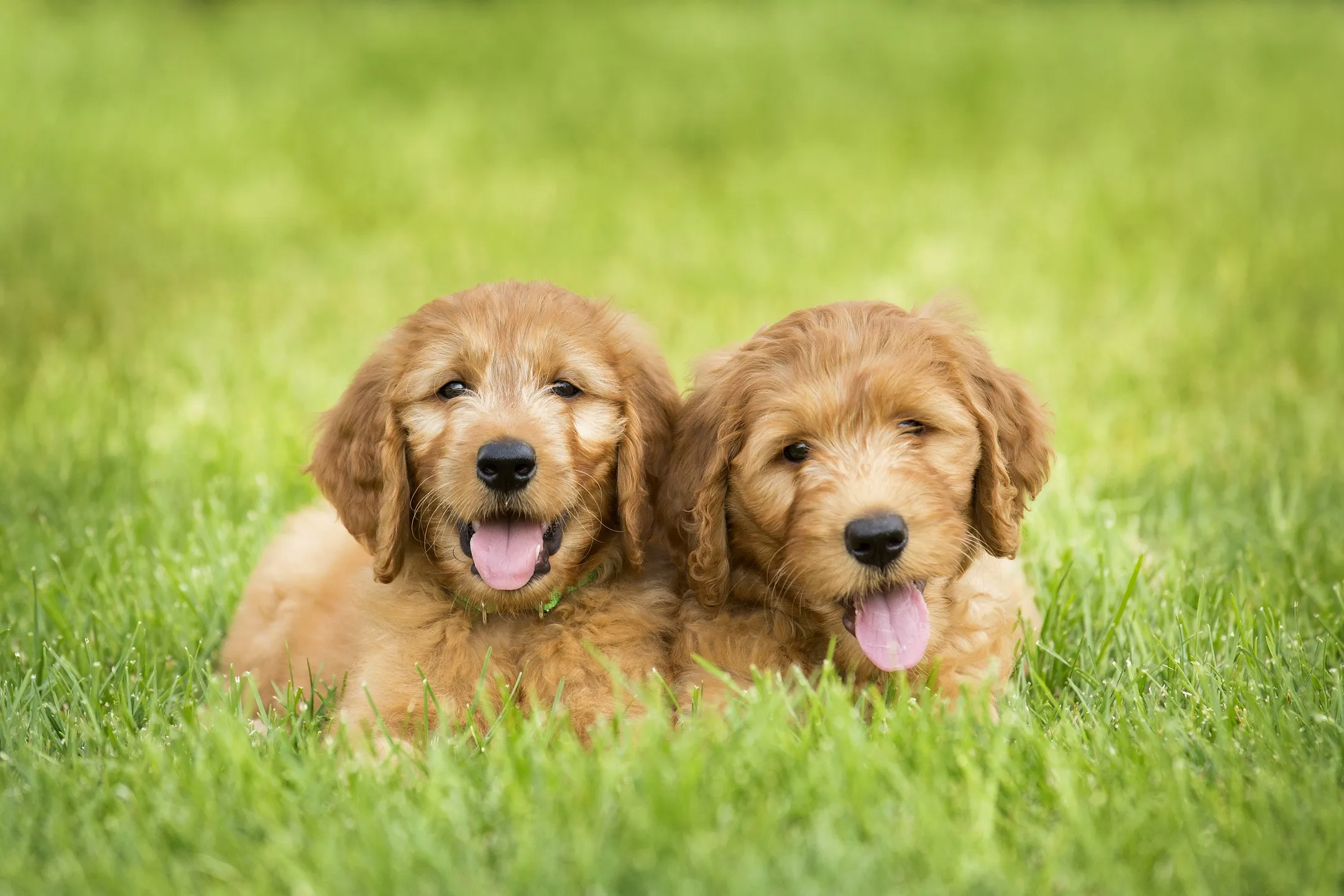Medium Size Poodle
The Goldendoodle isn't a breed, but a pairing between Golden Retrievers and Medium or Standard Poodles. Marketed as a low-maintenance dog for allergy sufferers, this hybrid is enjoying increasing popularity amongst dog lovers, similar to the Labradoodle.

© renaschild / stock.adobe.com
A Goldendoodle’s appearance can be very different, as there is no standard. Sometimes they are closer to Poodles in terms of appearance, but the Goldie side can still be recognised. Many Goldendoodles look like cuddly four-legged teddies. The fur can be smooth or wavy and is mostly semi-long. The Poodle variety of the parents is crucial in terms of sizes, though puppies can grow in different ways too. They can reach a shoulder height of between 75 and 30cm and the weight fluctuates too. Goldendoodles are mostly cream-coloured, black, brown or have fur in different shades. They are usually slender and sporty, though there are of course exceptions, particularly if robust Golden Retrievers were amongst the ancestors.
The Goldendoodle is one of the designer hybrids that are currently in fashion. The basic idea emerged in the 1980s, when Wally Conron wanted to breed a guide dog for allergy sufferers in Australia. Proven assistance dogs, i.e. Labrador Retrievers, were on hand. Conron believed that they could be paired with Poodles that do not moult in order to end up with a guide dog for allergy sufferers. Although there were initially no buyers for this mix, things changed as soon as a name was found that lended itself to advertising. Suddenly numerous dog lovers were interested in the cuddly-looking Labradoodle. Not only did the mix become famous overnight, but something happened that Wally Conron had never intended. His “invention” paved the way for a full-on wave of designer dogs. This is how we come to the Goldendoodle, which is also one of the new designer dogs and a cross between the Golden Retriever and Poodle.
As cute as some Goldendoodles may look, they are still hybrids. We will explain why this can be a problem for non-breeders. There is no prospect of recognition from large associations on the horizon. Ideally, breeders generally only work with pedigree Poodles and Golden Retrievers to end up with a Goldendoodle. This is because pairing these breeds is only somewhat predictable for the first generation in terms of the characteristics of the puppies. However, this is no longer the case for the second generation. Hence, it’s difficult to predict what will happen when two Goldendoodles are paired.
Both Poodles and Golden Retrievers are usually friendly, open dogs that enjoy living with families – provided that they get enough stimulation. Golden Retrievers in particular were falsely classed as cuddly companion dogs more and more in the last few years, leading to numerous under-stimulated dogs from this breed putting on weight and suffering from boredom. This doesn’t do justice to their character, since Golden Retrievers are working dogs that need to be occupied in order to be settled. So what do the characters of the Poodle and Goldie mean for the Goldendoodle? Goldendoodles are usually friendly and socially compatible surprise packages that are, like all dogs, greatly influenced by the training and socialisation they get during the first few weeks of their life.
 © Vickey / stock.adobe.com
© Vickey / stock.adobe.com
You will read in some places that hybrids are healthier and suffer from hereditary diseases less frequently than pedigree dogs. This isn’t necessarily correct though, because reputable breeders of pedigree dogs will set great store by comprehensive healthcare provision. Sick pedigree dogs are more common if breeders focus more on profit than the health of their puppies. Unfortunately it is now the case with many Goldendoodles that they take the worst rather than the best of the two breeds when it comes to health matters. This is because it is very rare for the best specimens of the two breeds to be available for breeding hybrids. A prized and responsibly bred Golden Retriever with healthy hips will either be used for breeding other Golden Retrievers or given away to aficionados. Due to the large number of Golden Retrievers – in Germany alone, around 2,200 Golden Retriever puppies are registered annually – there are numerous breeders focused on quantity over quality who jump on the bandwagon and breed without paperwork or paying attention to character and health, therefore the breed can be afflicted by problems from the outset.
Both parents of a Goldendoodle should be tested for diseases typical of their breed before they can produce offspring. Standard Poodles and Golden Retrievers tend to suffer from hip dysplasia (HD), which is why breeders should be able to prove that the parent animals have no health problems relating to their hips. Other possible diseases are progressive retinal atrophy (PRA), which can be ruled out by a genetic test, and kidney diseases. Due to the mix of Poodle and Goldie fur, Goldendoodles can also suffer from problems with their skin and fur.
Like all dogs, Goldendoodles need a high-quality diet primarily made up of meat. Choose a wet or dry food with a high proportion of meat and free of grain and sugar. Your companion needs up to four portions a day when it is a puppy, whilst adult Goldendoodles cope with two meals. After eating, your dog should always be able to rest in order to avoid the danger of stomach twist. Whilst Poodles rarely have problems with their weight, some Golden Retrievers tend to be greedy and put on weight quickly. Your task is to prevent this: weigh adult dogs every two weeks in order to spot changes in weight early on and be able to counteract this. If you give your dog treats, you should opt for healthy snacks like freeze-dried meat or dental care snacks. Bear in mind though that little games or cuddles also make good treats – as well as being free of charge and calories! Fresh water should always be available to your Goldendoodle.
Grooming a Goldendoodle can be demanding, since there are no generalisations regarding the texture of the fur. If your dog doesn’t moult, you have to trim or shear it regularly. You’re best off getting a dog groomer to do this if you don’t have the required knowledge. Long fur on Goldendoodles can easily get matted depending on its type, therefore it should be brushed carefully every few days. You should also check after every walk whether little branches or leaves have got caught in the fur or if there is even an uninvited guest in the form of a tick. These should be tackled with tick tweezers. Make sure to regularly check the ears too, keep the eyes free from strands of hair that could cause irritations and check your Goldendoodle’s claws every few weeks. If required, they should be cut with special claw clippers for dogs.
Read more about parasites affecting dogs: get rid of ticks and fleas!
 © everydoghasastory / stock.adobe.com
© everydoghasastory / stock.adobe.com
A healthy Goldendoodle is suitable for numerous tasks. Be it agility, dog dancing or tricks, they are happy to be involved with everything. Make sure that all activity takes into consideration your dog’s fitness level. You should only make a start on dog sports with adult Goldendoodles in order to prevent damaging the joints and skeleton. It goes without saying that Goldendoodles will enjoy long walks with you in the great outdoors. Since most dogs of this type are open and intelligent, they are worth considering for training as therapy dogs. Both Poodles and Golden Retrievers have water work in their genes, therefore many Goldendoodles like having the opportunity to swim.
It should be said in advance that if you suffer from a pet hair allergy, it can’t be predicted whether you will be able to live with a Goldendoodle without any complaints. In contrast to Poodles, these hybrids can moult heavily. This isn’t necessarily important though, because allergens are found in the saliva and skin flakes of dogs rather than their fur. Although dogs that don’t moult can be advantageous when it comes to mild allergies, they aren’t a guarantee. Unfortunately you still shouldn’t develop a false sense of security if you don’t suffer from an allergic reaction to puppies, since they barely release allergens. It would be better to spend a few hours in the breeder’s home in close proximity to both parent dogs in order to establish whether you develop any symptoms. If in doubt, ask your GP or dermatologist for advice.
Goldendoodles are friendly family dogs if they get suitable activity. However, training and socialisation also play a significant role and it can be difficult to find a responsible breeder. Although this is true of all dogs, these designer dogs with the teddy-bear look in particular sometimes create needs without the owners being aware of the demands they pose. If Goldendoodles get bored, they can develop behavioural disorders or even act aggressively. Don’t be fooled by the cuddly appearance: Goldendoodles are active and sporty dogs. They make good family dogs if they are well stimulated, but small children should never be left with them unsupervised. As well, they should always have the opportunity to retreat should they need their space. Cats can generally be well socialised with dogs, although dogs should ideally have already been familiar with cats since they were puppies. These hybrids don’t make suitable watchdogs though, because neither Poodles nor Golden Retrievers are particularly keen on vigilance.
Goldendoodles can be kept in large city apartments too if you spend plenty of time together outdoors. However, bear in mind that it shouldn’t climb stairs often. A fenced garden would be an ideal addition. The breed is in principle suitable for beginners. Before purchasing a dog, give thought to how you will manage grooming and activity and estimate the ongoing costs you will face. If the Goldendoodle is your first dog, there will also be the expenses for basic equipment ranging from bowls to travel crates for the car, as well as the purchase price for the puppy itself. A Goldendoodle puppy could cost between £500 and £1500.
If you’re looking for a Goldendoodle, you will soon realise that it is very difficult to find a reputable breeder. Only few examine the parent animals from both breeds for diseases typical of each breed and make sure they have passed a breed suitability test. Many Goldendoodles sense an opportunity to make a quick buck from these tousle-haired hybrids. Don’t buy from them and ask yourself whether it absolutely has to be a Goldendoodle, or whether a Poodle or Golden Retriever aren’t equally suited to your wishes. Poodles in particular have an unfair image of being dogs for old ladies: they don’t moult, are very clever and playful and come in four different sizes.
If it does have to be a Goldendoodle, look for a responsible breeder who gives you information on healthcare provision and restrains themself when it comes to advertising claims like “dog for allergy sufferers”. If it doesn’t have to be a puppy, you can now strike lucky in animal shelters too where similar hybrids can be found – often from owners who had a different impression of designer dogs and ended up overwhelmed.
Here are some purchase proposals curated by the zooplus editorial team
The products featured have been carefully selected by our editorial staff and are available at the zooplus online pet shop. The selection does not constitute advertising for the mentioned brands
Fans of the Bearded Collie agree that those who aren't familiar with this dog breed simply have to get acquainted with it. And those who have experienced how a Bearded Collie bolts across meadows with its flowing fur, how it rolls around full of energy and joy and how it attentively and observantly takes into account its owners wishes become simply addicted to this original dog breed and its unique charm.
The Goldendoodle isn't a breed, but a pairing between Golden Retrievers and Medium or Standard Poodles. Marketed as a low-maintenance dog for allergy sufferers, this hybrid is enjoying increasing popularity amongst dog lovers, similar to the Labradoodle.